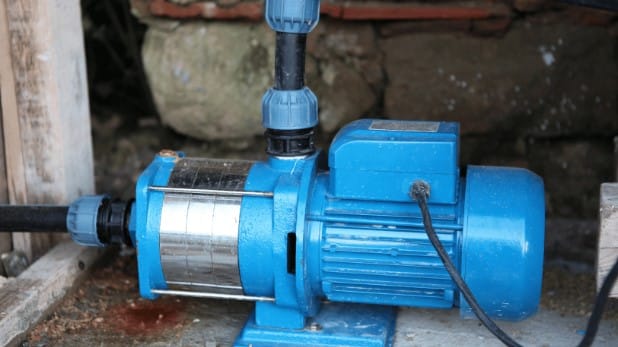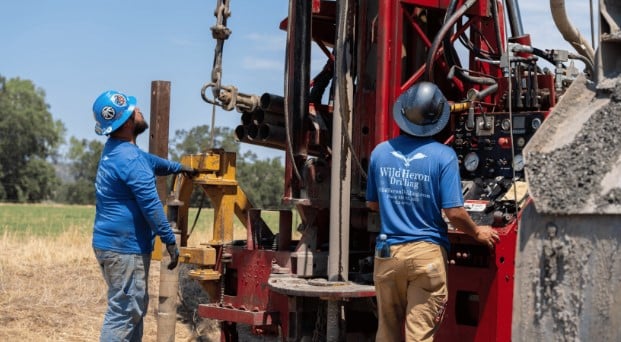Well Water Pressure Tank
Everything you need to know about your system.
Are you a homeowner with a well water system? If so, you may have heard of a well water pressure tank. This critical component of your well system is crucial in maintaining adequate water pressure throughout your home.
Let’s cover everything you need about your well water pressure tank. From how it works to everyday issues you may encounter, we’ve got you covered.
Whether you have a submersible pump or a jet pump, a diaphragm or bladder tank, we’ll explain how your pressure tank works and why it’s essential to your well system’s overall function.
What are the Main Purposes of Well Pumps Pressure Tanks?
A pressure tank in your well system serves one primary purpose: regulating the water pressure flowing to your faucets. The tank does this by providing an airflow cushion—that is, it forces water out when the pump is on and compresses air when the pump shuts off.
When a well pump kicks on, it forces water from its source to plumbing fixtures. The pump shuts off when the desired water pressure (usually 40–50 psi) has been reached.
However, the water flows when the pump turns off, causing pressure to drop suddenly. A pressure tank helps keep that from happening by storing water under compressed air—the same principle used in a balloon or beach ball.
When you inflate one of these items, it fills with air; similarly, when you install a pressure tank in your well system, a balloon-like bladder inside fills with air while storing some water. This compressed air exerts pressure against the stored water, forcing it through household pipes whenever needed.
What are the Different Types of Pressure Tanks?
When it comes to well water pressure tanks, there are two main types: diaphragm tanks and bladder tanks. Both types function similarly by utilizing compressed air to maintain water pressure, but they have some key differences.
Diaphragm Tanks
Diaphragm tanks have a vinyl or rubber diaphragm that separates the air from the water in the tank. When the water is pumped into the tank, it pushes against the diaphragm, causing it to stretch upward and compress the air on the other side. This compressed air exerts pressure on the water, forcing it out of the tank and into your home’s water system.
Bladder Tanks
Bladder tanks, on the other hand, use a balloon-like bladder to separate the air and water in the tank. When the pump turns on, water is pumped into the tank, and the bladder expands as it fills.
As the bladder expands, it stores water and compresses the air in the tank. When you turn on a faucet, this compressed air forces the water out of the tank and into your home’s water system.
Regardless of which type of pressure tank you have, it’s essential to understand how it works and how to maintain it to ensure your well water system is functioning correctly. In the next section, we’ll dive deeper into how your pressure tank works and some common issues you may encounter.

How Do Well Pressure Tanks Work On a Water Pump?
Understanding how a well pressure tank works with a water pump is crucial for maintaining a steady water supply to your home.
The Basics of Well Pressure Tanks
A well pressure tank is a type of water storage tank that is connected to your well pump.
Its main purpose is to maintain water pressure in your home by storing water under pressure until it’s needed. The pressure tank holds a certain amount of water, depending on its size, and has a set pressure range, typically between 20 and 60 pounds per square inch (psi).
The Role of the Pressure Switch
The pressure switch, connected to the well pump and pressure tank, controls when the pump turns on and off. When you turn on a faucet, the water pressure drops, causing the pressure switch to activate the well pump.
The pump then turns on and starts to lift water from the well, increasing the pressure in the tank. As the pressure increases, the increasingly compressed air in the tank forces water out of the tank and into your home’s water system.
Pump Cycles and Maximum Pressure
When the pressure in the tank reaches its maximum pressure, the pump shuts off, and the water flow stops. The pressure tank then holds the water until you turn on another faucet or fixture, and the process starts again.
The number of pump cycles depends on your water usage and the pressure tank size. It’s important to note that if the pressure drops below the default pressure setting, typically 20 psi, the relay switch light may indicate a problem with the system.
Understanding how your well pressure tank works with your water pump is essential for diagnosing and resolving any issues. In the next section, we’ll cover some common issues with pressure tanks and how to troubleshoot them.
Common Issues with Pressure Tanks
Short Cycling
One of the most common issues with pressure tanks is short cycling. This occurs when your well pump turns on and off frequently, which can cause excessive wear and tear on the system. Short cycling can be caused by several issues, including a faulty pressure switch or an improperly sized tank.
Waterlogged Tank
Another common issue with pressure tanks is a waterlogged tank. This occurs when the tank’s air pressure becomes too low, which can cause the tank to fill up with water. A waterlogged tank can cause low water pressure and damage your pump and pressure switch.

Wrapping Up
In conclusion, your pressure tank is crucial in maintaining the proper water pressure in your home or business. Storing and regulating the water and air pressure in the tank ensures a steady flow of water throughout the system. However, pressure tanks may experience issues like any other mechanical system and require maintenance or repair. Awareness of the common problems associated with pressure tanks is crucial.
If you experience issues with your well water pressure tank or would like to schedule routine maintenance, contact WildHeronDrilling. Our team of experienced professionals can diagnose and repair any pressure tank issues you may be experiencing and help ensure your well pump system continues to provide a reliable and consistent water supply for your home or business.
Don’t overlook the importance of your pressure tank in maintaining the quality and availability of your water supply. Take care of it, and it will take care of you.
